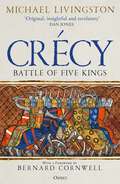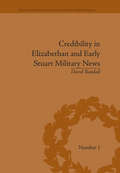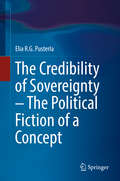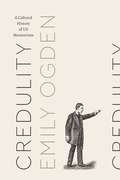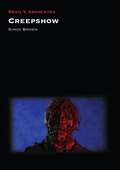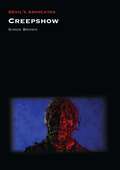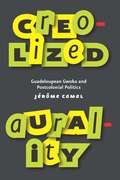- Table View
- List View
Crécy: Battle of Five Kings
by Michael Livingston'Like Crécy itself, this book is a triumph and the tale it tells gives an old story new life.'BERNARD CORNWELL, bestselling author of The Last Kingdom seriesA groundbreaking new study of the battle of Crécy, in which the outnumbered English under King Edward III won a decisive victory over the French and changed the course of the Hundred Years War. The battle of Crécy in 1346 is one of the most famous and widely studied military engagements in history. The repercussions of this battle were felt for hundreds of years, and the exploits of those fighting reached the status of legend. Yet cutting-edge research has shown that nearly everything that has been written about this dramatic event may be wrong.In this new study, Michael Livingston reveals how modern scholars have used archived manuscripts, satellite technologies and traditional fieldwork to help unlock what was arguably the battle's greatest secret: the location of the now quiet fields where so many thousands died. Crécy: Battle of Five Kings is a story of past and present. It is a new history of one of the most important battles of the Middle Ages: a compelling narrative account of the battle of Crécy that still adheres to the highest scholarly standards in its detail. It is also an account that incorporates the most cutting-edge revelations and the personal story of how those discoveries were made.
Credibility in Elizabethan and Early Stuart Military News (Political and Popular Culture in the Early Modern Period)
by David RandallElizabethan and early Stuart England saw the prevailing medium for transmitting military news shift from public ritual, through private letters, to public newspapers. This study is based on an examination of hundreds of manuscript news letters, printed pamphlets and corantos, and news diaries which are in holdings in the US and the UK.
Credibility in Elizabethan and Early Stuart Military News (Political and Popular Culture in the Early Modern Period #1)
by David RandallElizabethan and early Stuart England saw the prevailing medium for transmitting military news shift from public ritual, through private letters, to public newspapers. This study is based on an examination of hundreds of manuscript news letters, printed pamphlets and corantos, and news diaries which are in holdings in the US and the UK.
The Credibility of Sovereignty – The Political Fiction of a Concept
by Elia R.G. PusterlaThe book deeply analyses the bilateral relations between Switzerland and the European Union and their effect on the former's sovereignty in the context of Europeanisation. This touches on philosophical debates on the complexity of sovereignty. What sovereignty is at stake when talking about Swiss-EU relations? This issue not only faces the elusiveness of sovereignty as a concept, but also the proliferation of hypocrisy on its presence within states. The book encounters the deconstructionist hypothesis stating that there is nothing to worry about but the belief there is something to worry about. Derrida’s deconstruction of sovereignty allows indeed one to grasp the fictional essence of sovereignty based on the metaphysics of presence. The presence of self-positing sovereign ipseity is fictional since absent in the present, but spectrally present in the belief of its presence to come. Sovereignty is a matter of credibility, or the credible promise of a normative statement to come. Hence, the book challenges the realist/neorealist argument stating that states are credibly sovereign until proven otherwise and explains that the debate on state sovereignty calls for the unveiling of this hypocritical epistemology cunningly disguised as an objective presence. Swiss-EU relations thus become the cornerstone to not only theorise but also test sovereignty and deconstruct the two ontological and epistemological sides of the same coin, or the modern hypocrisy of sovereignty. This deconstruction constitutes the very problématique of any attempt to understand whether and how a state can be sovereign and solve the problem as to how to neutralise the différance and identify the difference between credible and incredible claims of sovereignty. This problématique connects the theory and practice of sovereignty innovatively, providing positivist evidence on the arguable credibility of the Swiss claim of sovereignty and confirming the presence of a theological dimension within politics.
Credit and Crisis from Marx to Minsky
by Jan ToporowskiThis timely book studies the economic theories of credit cycles and disturbances in the 20th century, presenting a nuanced view of the role of finance in the economy after the financial crash of 2008. Focusing on the work of economists from Marx onwards, Jan Toporowski moves beyond conventional monetary theory to offer an insightful critical alternative to current financial macroeconomics. The book features an extended discussion of Marx’s approach to credit and finance, new insights to Minsky’s ideas and a reconsideration of the financial theories of Kalecki and Steindl. Economic researchers and postgraduate students seeking to extend their knowledge of critical approaches to finance will find this an invaluable read, as well as practitioners and policy makers who seek to understand financial instability and unstable markets. This will also be an insightful read for economic historians looking to understand the nuances of different key economic theories and their practical applications.
Credit and Trade in Later Medieval England, 1353-1532 (Palgrave Studies in the History of Finance)
by Richard GoddardThis book challenges the notion that economic crises are modern phenomena through its exploration of the tumultuous ‘credit-crunch’ of the later Middle Ages. It illustrates clearly how influences such as the Black Death, inter-European warfare, climate change and a bullion famine occasioned severe and prolonged economic decline across fifteenth century England. Early chapters discuss trends in lending and borrowing, and the use of credit to fund domestic trade through detailed analysis of the Statute Staple and rich primary sources. The author then adopts a broad-based geographic lens to examine provincial credit before focusing on London’s development as the commercial powerhouse in late medieval business. Academics and students of modern economic change and historic financial revolutions alike will see that the years from 1353 to 1532 encompassed immense upheaval and change, reminiscent of modern recessions. The author carefully guides the reader to see that these shifts are the precursors of economic change in the early modern period, laying the foundations for the financial world as we know it today.
The Credit Crunch: Housing Bubbles, Globalisation and the Worldwide Economic Crisis
by Graham TurnerThis book argues that the current financial turmoil signals a crisis in globalisation that will directly challenge the free market economic model.*BR**BR*Graham Turner shows that the housing bubbles in the West were deliberately created to mask the damage inflicted by companies shifting production abroad in an attempt to boost profits. As these bubbles burst, economic growth in many developed countries will inevitably tumble. The Japanese crisis of the 1990s shows that banks and governments may struggle to contain the fallout. The problem has not been limited to the US, UK and Europe: housing bubbles have become endemic across wide swathes of emerging market economies. As the West slides, these countries will see an implosion of their credit bubbles too, shaking their faith in the free market. *BR**BR*Turner is an experienced and successful economic forecaster, whose opinions are sought by large international banks and top financial journalists. Drawing from his first hand experience of the Japanese property crash of the 1990s, he presents his analysis in a clear and persuasive style, showing that the end of housing market growth spells disaster for neoliberal globalisation.
Credit, Currency, and Capital: The Scottish Financial Revolution, 1690-1727 (Political Economies of Capitalism, 1600-1850)
by Andrew McDiarmidThe years 1690–1727 represented a period of significant change for Scotland. It was a time of grand colonial endeavours and financial innovation, punctuated by bouts of economic turmoil and constitutional and political uncertainty. The infamous Darien Scheme, the establishment of the Bank of Scotland and the Royal Bank of Scotland, the Anglo-Scots Union, the Hanoverian Succession, and the Jacobite rising of 1715, all occurred during this short time span. Therefore, it was not only a period that presented Scotland with opportunities but also a period in which the country ultimately lost its autonomy. It was also during these years, and against this unsettled backdrop, that the Scottish Financial Revolution commenced. The complexity of the Scottish situation during the late seventeenth and the early eighteen centuries has historically made the identification of a Scottish Financial Revolution difficult. This monograph, the first dedicated to the topic, addresses this problem and provides a model for identifying and understanding the revolution through the economic, political, and constitutional contexts of the period. Using examples of financial developments and innovation driven by Scotsmen in Scotland, Europe, and the colonies, this work defines the Scottish Financial Revolution as a series of developments which took place in Scotland when political circumstances allowed, but which also occurred outwith Scotland through the agency of members of the Scottish diaspora. This monograph is therefore the story of how Scotsmen at home and abroad contributed to financial debate and development between 1690 and 1727. Credit, Currency, and Capital: The Scottish Financial Revolution, 1690–1727 will appeal to students and scholars interested in the history of Economics and Finance. It will also be of interest to those studying the history of the Anglo-Scots Union and the complex relationship between Scotland and England.
Credit, Currency, and Capital: The Scottish Financial Revolution, 1690-1727 (Political Economies of Capitalism, 1600-1850)
by Andrew McDiarmidThe years 1690–1727 represented a period of significant change for Scotland. It was a time of grand colonial endeavours and financial innovation, punctuated by bouts of economic turmoil and constitutional and political uncertainty. The infamous Darien Scheme, the establishment of the Bank of Scotland and the Royal Bank of Scotland, the Anglo-Scots Union, the Hanoverian Succession, and the Jacobite rising of 1715, all occurred during this short time span. Therefore, it was not only a period that presented Scotland with opportunities but also a period in which the country ultimately lost its autonomy. It was also during these years, and against this unsettled backdrop, that the Scottish Financial Revolution commenced. The complexity of the Scottish situation during the late seventeenth and the early eighteen centuries has historically made the identification of a Scottish Financial Revolution difficult. This monograph, the first dedicated to the topic, addresses this problem and provides a model for identifying and understanding the revolution through the economic, political, and constitutional contexts of the period. Using examples of financial developments and innovation driven by Scotsmen in Scotland, Europe, and the colonies, this work defines the Scottish Financial Revolution as a series of developments which took place in Scotland when political circumstances allowed, but which also occurred outwith Scotland through the agency of members of the Scottish diaspora. This monograph is therefore the story of how Scotsmen at home and abroad contributed to financial debate and development between 1690 and 1727. Credit, Currency, and Capital: The Scottish Financial Revolution, 1690–1727 will appeal to students and scholars interested in the history of Economics and Finance. It will also be of interest to those studying the history of the Anglo-Scots Union and the complex relationship between Scotland and England.
Credit Nation: Property Laws and Institutions in Early America (The Princeton Economic History of the Western World #104)
by Claire PriestHow American colonists laid the foundations of American capitalism with an economy built on creditEven before the United States became a country, laws prioritizing access to credit set colonial America apart from the rest of the world. Credit Nation examines how the drive to expand credit shaped property laws and legal institutions in the colonial and founding eras of the republic.In this major new history of early America, Claire Priest describes how the British Parliament departed from the customary ways that English law protected land and inheritance, enacting laws for the colonies that privileged creditors by defining land and slaves as commodities available to satisfy debts. Colonial governments, in turn, created local legal institutions that enabled people to further leverage their assets to obtain credit. Priest shows how loans backed with slaves as property fueled slavery from the colonial era through the Civil War, and that increased access to credit was key to the explosive growth of capitalism in nineteenth-century America.Credit Nation presents a new vision of American economic history, one where credit markets and liquidity were prioritized from the outset, where property rights and slaves became commodities for creditors' claims, and where legal institutions played a critical role in the Stamp Act crisis and other political episodes of the founding period.
Credit Nation: Property Laws and Institutions in Early America (The Princeton Economic History of the Western World #104)
by Claire PriestHow American colonists laid the foundations of American capitalism with an economy built on creditEven before the United States became a country, laws prioritizing access to credit set colonial America apart from the rest of the world. Credit Nation examines how the drive to expand credit shaped property laws and legal institutions in the colonial and founding eras of the republic.In this major new history of early America, Claire Priest describes how the British Parliament departed from the customary ways that English law protected land and inheritance, enacting laws for the colonies that privileged creditors by defining land and slaves as commodities available to satisfy debts. Colonial governments, in turn, created local legal institutions that enabled people to further leverage their assets to obtain credit. Priest shows how loans backed with slaves as property fueled slavery from the colonial era through the Civil War, and that increased access to credit was key to the explosive growth of capitalism in nineteenth-century America.Credit Nation presents a new vision of American economic history, one where credit markets and liquidity were prioritized from the outset, where property rights and slaves became commodities for creditors' claims, and where legal institutions played a critical role in the Stamp Act crisis and other political episodes of the founding period.
Credulity: A Cultural History of US Mesmerism (Class 200: New Studies in Religion)
by Emily OgdenFrom the 1830s to the Civil War, Americans could be found putting each other into trances for fun and profit in parlors, on stage, and in medical consulting rooms. They were performing mesmerism. Surprisingly central to literature and culture of the period, mesmerism embraced a variety of phenomena, including mind control, spirit travel, and clairvoyance. Although it had been debunked by Benjamin Franklin in late eighteenth-century France, the practice nonetheless enjoyed a decades-long resurgence in the United States. Emily Ogden here offers the first comprehensive account of those boom years. Credulity tells the fascinating story of mesmerism’s spread from the plantations of the French Antilles to the textile factory cities of 1830s New England. As it proliferated along the Eastern seaboard, this occult movement attracted attention from Ralph Waldo Emerson’s circle and ignited the nineteenth-century equivalent of flame wars in the major newspapers. But mesmerism was not simply the last gasp of magic in modern times. Far from being magicians themselves, mesmerists claimed to provide the first rational means of manipulating the credulous human tendencies that had underwritten past superstitions. Now, rather than propping up the powers of oracles and false gods, these tendencies served modern ends such as labor supervision, education, and mediated communication. Neither an atavistic throwback nor a radical alternative, mesmerism was part and parcel of the modern. Credulity offers us a new way of understanding the place of enchantment in secularizing America.
Credulity: A Cultural History of US Mesmerism (Class 200: New Studies in Religion)
by Emily OgdenFrom the 1830s to the Civil War, Americans could be found putting each other into trances for fun and profit in parlors, on stage, and in medical consulting rooms. They were performing mesmerism. Surprisingly central to literature and culture of the period, mesmerism embraced a variety of phenomena, including mind control, spirit travel, and clairvoyance. Although it had been debunked by Benjamin Franklin in late eighteenth-century France, the practice nonetheless enjoyed a decades-long resurgence in the United States. Emily Ogden here offers the first comprehensive account of those boom years. Credulity tells the fascinating story of mesmerism’s spread from the plantations of the French Antilles to the textile factory cities of 1830s New England. As it proliferated along the Eastern seaboard, this occult movement attracted attention from Ralph Waldo Emerson’s circle and ignited the nineteenth-century equivalent of flame wars in the major newspapers. But mesmerism was not simply the last gasp of magic in modern times. Far from being magicians themselves, mesmerists claimed to provide the first rational means of manipulating the credulous human tendencies that had underwritten past superstitions. Now, rather than propping up the powers of oracles and false gods, these tendencies served modern ends such as labor supervision, education, and mediated communication. Neither an atavistic throwback nor a radical alternative, mesmerism was part and parcel of the modern. Credulity offers us a new way of understanding the place of enchantment in secularizing America.
Credulity: A Cultural History of US Mesmerism (Class 200: New Studies in Religion)
by Emily OgdenFrom the 1830s to the Civil War, Americans could be found putting each other into trances for fun and profit in parlors, on stage, and in medical consulting rooms. They were performing mesmerism. Surprisingly central to literature and culture of the period, mesmerism embraced a variety of phenomena, including mind control, spirit travel, and clairvoyance. Although it had been debunked by Benjamin Franklin in late eighteenth-century France, the practice nonetheless enjoyed a decades-long resurgence in the United States. Emily Ogden here offers the first comprehensive account of those boom years. Credulity tells the fascinating story of mesmerism’s spread from the plantations of the French Antilles to the textile factory cities of 1830s New England. As it proliferated along the Eastern seaboard, this occult movement attracted attention from Ralph Waldo Emerson’s circle and ignited the nineteenth-century equivalent of flame wars in the major newspapers. But mesmerism was not simply the last gasp of magic in modern times. Far from being magicians themselves, mesmerists claimed to provide the first rational means of manipulating the credulous human tendencies that had underwritten past superstitions. Now, rather than propping up the powers of oracles and false gods, these tendencies served modern ends such as labor supervision, education, and mediated communication. Neither an atavistic throwback nor a radical alternative, mesmerism was part and parcel of the modern. Credulity offers us a new way of understanding the place of enchantment in secularizing America.
Credulity: A Cultural History of US Mesmerism (Class 200: New Studies in Religion)
by Emily OgdenFrom the 1830s to the Civil War, Americans could be found putting each other into trances for fun and profit in parlors, on stage, and in medical consulting rooms. They were performing mesmerism. Surprisingly central to literature and culture of the period, mesmerism embraced a variety of phenomena, including mind control, spirit travel, and clairvoyance. Although it had been debunked by Benjamin Franklin in late eighteenth-century France, the practice nonetheless enjoyed a decades-long resurgence in the United States. Emily Ogden here offers the first comprehensive account of those boom years. Credulity tells the fascinating story of mesmerism’s spread from the plantations of the French Antilles to the textile factory cities of 1830s New England. As it proliferated along the Eastern seaboard, this occult movement attracted attention from Ralph Waldo Emerson’s circle and ignited the nineteenth-century equivalent of flame wars in the major newspapers. But mesmerism was not simply the last gasp of magic in modern times. Far from being magicians themselves, mesmerists claimed to provide the first rational means of manipulating the credulous human tendencies that had underwritten past superstitions. Now, rather than propping up the powers of oracles and false gods, these tendencies served modern ends such as labor supervision, education, and mediated communication. Neither an atavistic throwback nor a radical alternative, mesmerism was part and parcel of the modern. Credulity offers us a new way of understanding the place of enchantment in secularizing America.
Credulity: A Cultural History of US Mesmerism (Class 200: New Studies in Religion)
by Emily OgdenFrom the 1830s to the Civil War, Americans could be found putting each other into trances for fun and profit in parlors, on stage, and in medical consulting rooms. They were performing mesmerism. Surprisingly central to literature and culture of the period, mesmerism embraced a variety of phenomena, including mind control, spirit travel, and clairvoyance. Although it had been debunked by Benjamin Franklin in late eighteenth-century France, the practice nonetheless enjoyed a decades-long resurgence in the United States. Emily Ogden here offers the first comprehensive account of those boom years. Credulity tells the fascinating story of mesmerism’s spread from the plantations of the French Antilles to the textile factory cities of 1830s New England. As it proliferated along the Eastern seaboard, this occult movement attracted attention from Ralph Waldo Emerson’s circle and ignited the nineteenth-century equivalent of flame wars in the major newspapers. But mesmerism was not simply the last gasp of magic in modern times. Far from being magicians themselves, mesmerists claimed to provide the first rational means of manipulating the credulous human tendencies that had underwritten past superstitions. Now, rather than propping up the powers of oracles and false gods, these tendencies served modern ends such as labor supervision, education, and mediated communication. Neither an atavistic throwback nor a radical alternative, mesmerism was part and parcel of the modern. Credulity offers us a new way of understanding the place of enchantment in secularizing America.
Credulity: A Cultural History of US Mesmerism (Class 200: New Studies in Religion)
by Emily OgdenFrom the 1830s to the Civil War, Americans could be found putting each other into trances for fun and profit in parlors, on stage, and in medical consulting rooms. They were performing mesmerism. Surprisingly central to literature and culture of the period, mesmerism embraced a variety of phenomena, including mind control, spirit travel, and clairvoyance. Although it had been debunked by Benjamin Franklin in late eighteenth-century France, the practice nonetheless enjoyed a decades-long resurgence in the United States. Emily Ogden here offers the first comprehensive account of those boom years. Credulity tells the fascinating story of mesmerism’s spread from the plantations of the French Antilles to the textile factory cities of 1830s New England. As it proliferated along the Eastern seaboard, this occult movement attracted attention from Ralph Waldo Emerson’s circle and ignited the nineteenth-century equivalent of flame wars in the major newspapers. But mesmerism was not simply the last gasp of magic in modern times. Far from being magicians themselves, mesmerists claimed to provide the first rational means of manipulating the credulous human tendencies that had underwritten past superstitions. Now, rather than propping up the powers of oracles and false gods, these tendencies served modern ends such as labor supervision, education, and mediated communication. Neither an atavistic throwback nor a radical alternative, mesmerism was part and parcel of the modern. Credulity offers us a new way of understanding the place of enchantment in secularizing America.
Creepshow (Devil's Advocates)
by Simon BrownReleased in cinemas in 1982, Creepshow is typically regarded as a minor entry in both the film output of George A. Romero and the history of adaptations of the works of Stephen King. Yet this lack of critical attention hides the fact that Creepshow is the only full collaboration between America’s bestselling author of horror tales and one of the masters of modern American horror cinema. Long considered too mainstream for the director of Dawn of the Dead (1978), too comic for the author that gave audiences the film versions of Carrie (1976) and The Shining (1980), and too violent for a cinemagoing public turning away from gore cinema in the autumn of 1982, Creepshow is here reassessed by Simon Brown, who examines the making and release of the film and its legacy through a comic book adaptation and two sequels. His analysis focuses on the key influences on the film, not just Romero and King, but also the anthology horrors of Amicus Productions, body horror cinema, and the special make up effects of Tom Savini, the relationship between horror and humor, and most notably the tradition of EC horror comics of the 1950s, from which the film draws both its thematic preoccupations and its visual style. Ultimately the book argues that not only is Creepshow a major work in the canons of Romero and King, but also that it represents a significant example of the portmanteau horror film, of the blending of horror and comedy, and finally, decades before the career of Zack Snyder (Watchmen, Man of Steel), of attempting to recreate a comic book aesthetic on the big screen.
Creepshow (Devil's Advocates)
by Simon BrownReleased in cinemas in 1982, Creepshow is typically regarded as a minor entry in both the film output of George A. Romero and the history of adaptations of the works of Stephen King. Yet this lack of critical attention hides the fact that Creepshow is the only full collaboration between America’s bestselling author of horror tales and one of the masters of modern American horror cinema. Long considered too mainstream for the director of Dawn of the Dead (1978), too comic for the author that gave audiences the film versions of Carrie (1976) and The Shining (1980), and too violent for a cinemagoing public turning away from gore cinema in the autumn of 1982, Creepshow is here reassessed by Simon Brown, who examines the making and release of the film and its legacy through a comic book adaptation and two sequels. His analysis focuses on the key influences on the film, not just Romero and King, but also the anthology horrors of Amicus Productions, body horror cinema, and the special make up effects of Tom Savini, the relationship between horror and humor, and most notably the tradition of EC horror comics of the 1950s, from which the film draws both its thematic preoccupations and its visual style. Ultimately the book argues that not only is Creepshow a major work in the canons of Romero and King, but also that it represents a significant example of the portmanteau horror film, of the blending of horror and comedy, and finally, decades before the career of Zack Snyder (Watchmen, Man of Steel), of attempting to recreate a comic book aesthetic on the big screen.
Creole Gentlemen: The Maryland Elite, 1691-1776 (New World in the Atlantic World)
by Trevor BurnardExamining the lives of 460 of the wealthiest men who lived in colonial Maryland, Burnard traces the development of this elite from a hard-living, profit-driven merchant-planter class in the seventeenth century to a more genteel class of plantation owners in the eighteenth century. This study innovatively compares these men to their counterparts elsewhere in the British Empire, including absentee Caribbean landowners and East Indian nabobs, illustrating their place in the Atlantic economic network.
Creole Gentlemen: The Maryland Elite, 1691-1776 (New World in the Atlantic World)
by Trevor BurnardExamining the lives of 460 of the wealthiest men who lived in colonial Maryland, Burnard traces the development of this elite from a hard-living, profit-driven merchant-planter class in the seventeenth century to a more genteel class of plantation owners in the eighteenth century. This study innovatively compares these men to their counterparts elsewhere in the British Empire, including absentee Caribbean landowners and East Indian nabobs, illustrating their place in the Atlantic economic network.
Creole Identity in Postcolonial Indonesia (Integration and Conflict Studies #9)
by Jacqueline KnörrContributing to identity formation in ethnically and religiously diverse postcolonial societies, this book examines the role played by creole identity in Indonesia, and in particular its capital, Jakarta. While, on the one hand, it facilitates transethnic integration and promotes a specifically postcolonial sense of common nationhood due to its heterogeneous origins, creole groups of people are often perceived ambivalently in the wake of colonialism and its demise, on the other. In this book, Jacqueline Knörr analyzes the social, historical, and political contexts of creoleness both at the grassroots and the State level, showing how different sections of society engage with creole identity in order to promote collective identification transcending ethnic and religious boundaries, as well as for reasons of self-interest and ideological projects.
Creolised Science: Knowledge in the Eighteenth-Century Indo-Pacific (Science in History)
by null Dorit BrixiusThis rich, deeply researched study offers the first comprehensive exploration of cross-cultural plant knowledge in eighteenth-century Mauritius. Using the concept of creolisation – the process by which elements of different cultures are brought together to create entangled and evolving new entities – Brixius examines the production of knowledge on an island without long-established traditions of botany as understood by Europeans. Once foreign plants and knowledge arrived in Mauritius, they were adapted to new environmental circumstances and a new socio-cultural space. Brixius explores how French colonists, settlers, mediators, labourers and enslaved people experienced and shaped the island's botanical past, centring the contributions of subaltern actors. By foregrounding neglected non-European actors from both Africa and Asia, within a melting pot of cultivation traditions from around the world, she presents a truly global history of botanical knowledge.
Creolized Aurality: Guadeloupean Gwoka and Postcolonial Politics (Chicago Studies in Ethnomusicology)
by Jérôme CamalIn the Caribbean island of Guadeloupe, the complex interplay between anticolonial resistance and accommodation resounds in its music. Guadeloupean gwoka music—a secular, drum-based tradition—captures the entangled histories of French colonization, movements against it, and the uneasy process of the island’s decolonization as an overseas territory of France. In Creolized Aurality, Jérôme Camal demonstrates that musical sounds and practices express the multiple—and often seemingly contradictory—cultural belongings and political longings that characterize postcoloniality. While gwoka has been associated with anti-colonial activism since the 1960s, in more recent years it has provided a platform for a cohort of younger musicians to express pan-Caribbean and diasporic solidarities. This generation of musicians even worked through the French state to gain UNESCO heritage status for their art. These gwoka practices, Camal argues, are “creolized auralities”—expressions of a culture both of and against French coloniality and postcoloniality.
